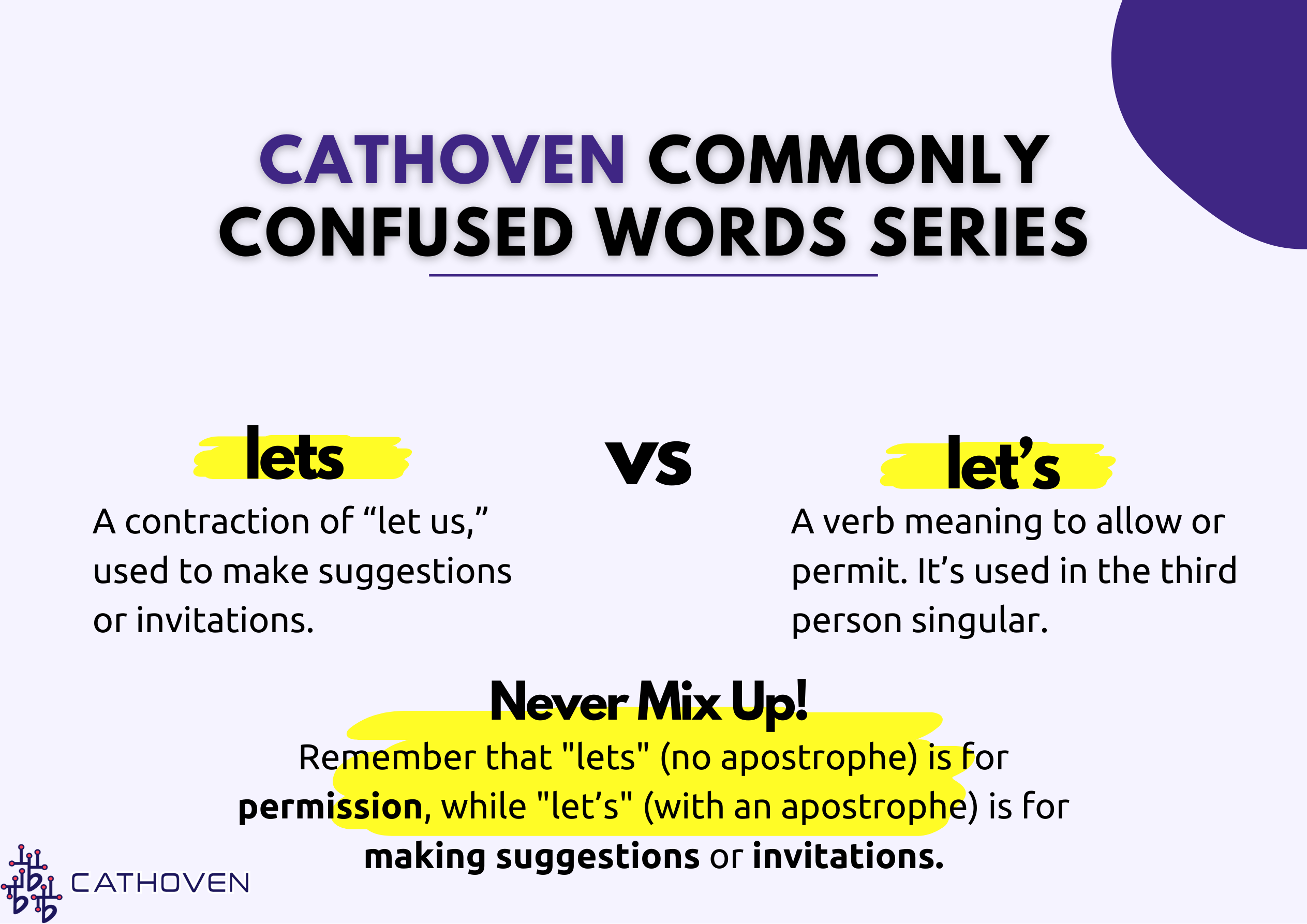“Lets” and “let’s” are commonly confused words due to their similar spelling and pronunciation. However, they have different meanings and uses. “Lets” is a third-person singular form of the verb “let,” while “let’s” is a contraction of “let us.” This blog post will explain the differences between the two and provide examples to help you use them correctly.
We will also include CEFR insights to show how learners at different levels can understand and practice these terms.
What is “lets”?
“Lets” is the third-person singular form of the verb “let,” which means to allow or permit someone to do something. It’s used when talking about a person or thing that allows something to happen.
- CEFR Level: A2
“Lets” is typically introduced at the elementary level as learners start to understand permission and causative verbs.
Examples of “lets” in sentences:
- He lets his dog play in the park every evening. (A2)
- Simple sentence showing permission.
- The teacher lets students ask questions at the end of the class. (B1)
- A more specific scenario in a classroom context.
What is “let’s”?
“Let’s” is a contraction of “let us” and is used to make suggestions, proposals, or invitations. It’s commonly followed by a verb to indicate something you want to do together with someone else.
- CEFR Level: A2
“Let’s” is introduced at the A2 level to help learners make polite suggestions and requests in conversations.
Examples of “let’s” in sentences:
- Let’s go to the park! (A2).
- Simple suggestion for an activity.
- Let’s start the meeting at 10 AM. (B1)
- A more formal suggestion in a professional context.
Examples for Using "Lets"
A2 Level (Elementary):
- He lets his sister borrow his bike whenever she wants.
- Shows simple permission in a family context.
- My mom lets me stay up late on weekends.
- Everyday example of permission within a family setting.
B1 Level (Intermediate):
- The app lets users customize their profiles easily.
- More complex sentence showing technological permission.
- This restaurant lets you choose your own ingredients for the salad.
- Example from a service industry showing freedom of choice.
B2 Level (Upper-Intermediate):
- The university lets students access the library even after hours.
- A more formal context showing extended permission.
- This feature lets you share files with others in real time.
- Advanced technological use of “lets.”
C1 Level (Advanced):
- The policy lets employees work remotely during certain periods of the year.
- More advanced sentence showing a policy-related permission.
- This innovation lets companies reduce their energy consumption dramatically.
- Example in a business context highlighting efficiency.
Examples for Using "Let’s"
A2 Level (Elementary)
- Let’s go to the movies tonight.
- Simple invitation to a fun activity.
- Let’s take a break and have some coffee.
- Basic suggestion for a short break.
B1 Level (Intermediate):
- Let’s plan a trip to the countryside this weekend.
- More detailed suggestion about an upcoming event.
- Let’s meet at the cafe around 3 PM to discuss the project.
- A suggestion for a specific meeting time and place.
B2 Level (Upper-Intermediate):
- Let’s review the final draft before sending it to the client.
- More professional context showing collaboration.
- Let’s make sure we’ve covered all the key points before the presentation.
- Suggestion to ensure thorough preparation.
C1 Level (Advanced):
- Let’s not underestimate the complexity of the situation before we make a decision.
- More advanced sentence structure with a negative suggestion.
- Let’s consider all the options before committing to a course of action.
- Complex sentence showing careful consideration.
Key Differences Between "Lets" and "Let’s”
- Lets: A verb meaning to allow or permit. It’s used in the third person singular.
Example: She lets her children stay up late on weekends.
- Let’s: A contraction of “let us,” used to make suggestions or invitations.
Example: Let’s order pizza for dinner tonight.
Cathoven’s AI-powered tools can assist teachers and learners in practicing important concepts through real-life scenarios. For example, the Exercise Creator allows you to generate comprehension exercises by simply providing a text. To make it easier, we’ve created an example text for you—just click ‘use example text‘ to get started. Once the text is in place, you can create multiple-choice questions, true/false, and short-answer questions.

Click the “use an example text” below and start creating questions to measure your students’ understanding of lets and let’s!
Try with your own text right now (simple version)
Multiple choice
Number of remaining chances: 3
The result will be shown here:
*No credit card or upfront payment required to use
Frequently Asked Questions about "Lets" vs "Let’s"
"Lets" means to allow or permit something to happen.
"Let’s" is a contraction of "let us" and is used to make suggestions or invitations.
Remember that "lets" (no apostrophe) is for permission, while "let’s" (with an apostrophe) is for making suggestions or invitations.
